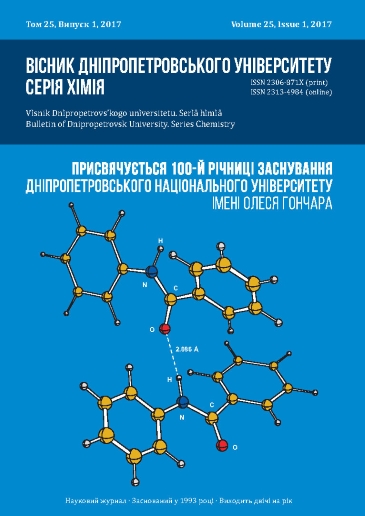Corrigendum
DOI:
https://doi.org/10.15421/081707Keywords:
aminolysis, 3, 4-epoxysulfolane, configuration, amino alcoholAbstract
Zarovnaya, I. S., Sadkova, I. V., Kulakov, I. V., Dulnev, P. G., Palchikov, V. A. (2013). New oxazіlines with sulfolane frame. Bull. Dnipropetrovsk Univ. Ser. Chem., 21(20), 21–30 (in Russian). doi: https://doi.org/10.15421/081315
Zarovnaya, I. S., Tokar, A. V., Palchikov, V. A. (2014). Features of interaction isomeric 4-amino-tetrahydrothiophen-3-ol-1,1-dioxide with some C-electrophilic reagents. Bull. Dnipropetrovsk Univ. Ser. Chem., 22(2), 39–46 (in Ukrainian). doi: https://doi.org/10.15421/081419
Aminolysis of 3,4-epoxysulfolane in aqueous media leads to a very complex mixture of products with unresolved stereochemistry. Herein, we report revised data refer to our previously published results in this journal. According to our 2D NMR and XRD study sulfolane-based amino alcohols with m.p. 189–192˚С and 102–105˚С have cis- and trans-configuration respectively (CCDC 1527144 for cis-isomer, CCDC 1527143 for trans-isomer). Detailed analytical data obtained in the course of our work will be useful for the stereochemical identification of new sulfolane derivatives.
References
Zarovnaya, I. S., Sadkova, I. V., Kulakov, I. V., Dulnev, P. G., Palchikov, V. A. (2013). [New oxazіlines with sulfolane frame]. Bull. Dnipropetrovsk Univ. Ser. Chem., 21(20), 21–30 (in Russian). doi: https://doi.org/10.15421/081315 CrossRef
Zarovnaya, I. S., Tokar, A. V., Palchikov, V. A. (2014). Features of interaction isomeric 4-aminotetrahydro-thiophen-3-ol-1,1-dioxide with some C-electrophilic reagents. Bull. Dnipropetrovsk Univ. Ser. Chem., 22(2), 39–46 (in Ukrainian). doi: https://doi.org/10.15421/081419 CrossRef
Sorenson, W. R. (1959). Epoxidation of butadiene sulfone. J. Org. Chem., 24(11), 1796–1798. doi: https://doi.org/10.1021/jo01093a612 CrossRef
Mukhamedova, L. A., Kursheva, L. I., Anoshina, N. P. (1978). Mechanism of the reaction of 3,4-epoxysulfolanes with ammonia and amines. Chem. Heterocycl. Compd., 14(1), 23–27. doi: https://doi.org/10.1007/BF00635936 CrossRef
Xue, F., Seto, C. T. (2006). Structure-activity studies of cyclic ketone inhibitors of the serine protease plasmin: Design, synthesis, and biological activity. Bioorg. Med. Chem., 14(24), 8467–8487. doi: https://doi.org/10.1016/j.bmc.2006.08.040 CrossRef
Prochazka, M. Horak, V. (1959). Über sulfolane IV. Reaktion der halogen- und tosyloxysulfolane mit ammoniak. Coll. Czech. Chem. Commun., 24(7), 2278 2283. doi: https://doi.org/10.1135/cccc19592278 CrossRef
Mahan, J. E., Fauske, S. C. (1952). US Patent No. 2610192. Retrieved from Espacenet.
Eissenstat, M. A., Weaver, J. D. (1993). A retro-Diels-Alder approach to oxazoles and imidazoles. J. Org. Chem., 58(12), 3387–3390. doi: https://doi.org/10.1021/jo00064a029 CrossRef
Ghosh, A. K., Fidanze, S., Senanayake, C. H. (1998). Сis-1-Aminoindan-2-ol in asymmetric syntheses. Synthesis, (7), 937–961. doi: https://doi.org/10.1055/s-1998-2092 CrossRef
McCasland, G. E., Smith, D. A. (1950). Stereochemistry of aminocyclanols. Synthesis of cis epimers via oxazolines. The 2-aminocyclopentanols. J. Am. Chem. Soc., 72(5), 2190–2195. doi: https://doi.org/10.1021/ja01161a089 CrossRef
Winstein, S., Grunwald, E., Buckles, R. E., Hanson, C. (1948). The role of neighboring groups in replacement reactions. XI. Some reactivities involving neighboring groups. J. Am. Chem. Soc., 70(2), 816–821. doi: https://doi.org/10.1021/ja01182a112 CrossRef
Kavadias, G., Droghini, R. (1979). Aminocyclitols. III. Synthesis of diaminocyclohexanediols. Can. J. Chem., 57(14), 1870–1876. doi: https://doi.org/10.1139/v79-296 CrossRef
Bezmenova, T. É., Dul'nev, P. G., Rybakova, M. V. (1980). A study of the conditions of the formation of the cis- and trans-isomers of N-substituted 4-aminothiolan-3-ol-1,1-dioxides. Chem. Heterocycl. Compd., 16(4), 359–362. doi: https://doi.org/10.1007/BF00552774 CrossRef
Dul'nev, P. G., Bezmenova, T. É. (1974). USSR Patent No. 420630. Retrieved from http://patents.su/2-420630-sposob-polucheniya-nitrofenilaminosulfolanov-ili-sootvetstvuyushhikh-sulfolenov.html patents.su
Chou, T., Chen, H.-C., Tsai, C.-Y. (1994). Preparation of (phenyloxazolo)-3-sulfolene. A precursor for (phenyl-oxazolo)-O-quinodimethane. J. Org. Chem., 59(8), 2241–2245. doi: https://doi.org/10.1021/jo00087a049 CrossRef
Khaskin, G. I., Bezmenova, T. É., Grib, O. K., Smolina, A. I., Korshun, M. N. (1984). USSR Patent No. 961338. Retrieved from http://patents.su/3-961338-2-trikhlor-metiltiolano-3-4-oksazo-lidin-5-5-dioksid-obladayushhijj-nematicidnym-dejjstviem.html patents.su
Bezmenova, T. É., Dul'nev, P. G., Malyuk, L. G., Rudzit, E. A., Kulikova, I. A. (1986). USSR Patent No. 745161. Retrieved from http://patents.su/3-745161-sulfolano-3-4-oksazolidin-2-tien-obladayushhijj-protivogribkovojj-aktivnostyu-i-sposob-ego-polucheniya.html patents.su
Bezmenova, T. É, Rozhenko, A. B., Khaskin, G. I., Bratunets, A. F., Shakhnvorost, A. M. (1988). Condensed thiolane 1,1-dioxide system. Chem. Heterocycl. Compd., 24(2), 225–228. doi: https://doi.org/10.1007/BF00473338 CrossRef
Khaskin, G. I., Bezmenova, T. É. (1983). New method for the synthesis of cis-perhydrothieno[3,4-d]imidazol-2-one 5,5-dioxides. Chem. Heterocycl. Compd., 19(2), 154–155. doi: https://doi.org/10.1007/BF00506423 CrossRef
Sukhoveev, V. V. (2001). Metal-complexes on the basis of derivative sulfolen-3: biological activity. Catalysis and petrochemistry, (7), 55–62 (in Ukrainian). Retrieved from http://kataliz.org.ua/arhiv/7_2001_en.html kataliz.org.ua
Liang, C., Gao, S., Li, Z. (2008). US Patent No. WO 2008/033562 A2. Retrieved from https://patentscope.wipo.int/search/en/detail.jsf?docId=WO2008033562 patentscope.wipo.int
Liang, C., Qi, M., Gao, S., Li, Z. (2009). US Patent No. US20090076005 A1. Retrieved from https://encrypted.google.com/patents/US20090076005?cl=ar patents.google.com/
Downloads
Published
Issue
Section
License
Copyright (c) 2017 Oles Honchar Dnipropetrovsk National University

This work is licensed under a Creative Commons Attribution 4.0 International License.
- Authors reserve the right of attribution for the submitted manuscript, while transferring to the Journal the right to publish the article under the Creative Commons Attribution License. This license allows free distribution of the published work under the condition of proper attribution of the original authors and the initial publication source (i.e. the Journal)
- Authors have the right to enter into separate agreements for additional non-exclusive distribution of the work in the form it was published in the Journal (such as publishing the article on the institutional website or as a part of a monograph), provided the original publication in this Journal is properly referenced
- The Journal allows and encourages online publication of the manuscripts (such as on personal web pages), even when such a manuscript is still under editorial consideration, since it allows for a productive scientific discussion and better citation dynamics (see The Effect of Open Access).


